
Concept explainers
Construct the ANOVA table and test for significance at 5% level.
Answer to Problem 58SE
The ANOVA table is given below:
| Source |
Degrees of freedom |
Sum of squares |
Mean sum of squares | F-ratio |
|
Vat pressure A | 1 | 6.94 | 6.94 | 11.57 |
|
Cooking time B | 3 | 5.61 | 1.87 | 3.12 |
|
Concentration C | 2 | 12.33 | 6.165 | 10.28 |
| Interaction AB | 3 | 4.05 | 1.35 | 2.25 |
| Interaction BC | 6 | 15.80 | 2.63 | 4.38 |
| Interaction AC | 2 | 7.32 | 3.66 | 6.10 |
| Interaction ABC | 6 | 4.37 | 0.728 | 1.21 |
| Error | 24 | 14.40 | 0.6 | |
| Total | 47 | 70.82 |
There is sufficient of evidence to conclude that there is an effect of vat pressure on the strength of the paper at 5% level of significance.
There is sufficient of evidence to conclude that there is an effect of cooking times on the strength of the paper at 5% level of significance.
There is sufficient of evidence to conclude that there is an effect of concentrations on the strength of the paper at 5% level of significance.
There is no sufficient of evidence to conclude that there is an interaction effect of vat pressure and cooking times on the strength of the paper at 5% level of significance.
There is sufficient of evidence to conclude that there is an interaction effect of cooking times and concentrations on the strength of the paper at 5% level of significance.
There is sufficient of evidence to conclude that there is an interaction effect of vat pressure and concentrations on the strength of the paper at 5% level of significance.
There is no sufficient of evidence to conclude that there is an interaction effect of vat pressure and concentrations on the strength of the paper at 5% level of significance.
Explanation of Solution
Given info:
An experiment was carried out to test the vat pressure A, cooking time of pulp B and hardwood concentration C on the strength of the paper.
The sum of squares of factor A is 6.94, due to factor B is 5.61, due to factor C is 12.33, due to interaction AB is 4.05, due to interaction BC is 15.80, due to interaction AC is 7.32, sum of squares due to error and total sum of squares is 14.40 and 70.82.
Two observations were made at each combination of factor levels.
Calculation:
The sum of squares due to the interaction of factor A, B and C is calculated as follows:
The general ANOVA table is given below:
| Source | Degrees of freedom | Sum of squares | Mean sum of squares | F-ratio |
| Factor A | ||||
| Factor B | ||||
| Factor C | ||||
| Interaction AB | ||||
| Error | ||||
| Total |
The ANOVA for the given data is shown below:
| Source | Degrees of freedom |
Sum of squares | Mean sum of squares | F-ratio |
|
Vat pressure A | 6.94 | 11.57 | ||
|
Cooking time B | 5.61 | 3.12 | ||
|
Concentration C | 12.33 | 10.28 | ||
| Interaction AB | 4.05 | 2.25 | ||
| Interaction BC | 15.80 | 4.38 | ||
| Interaction AC | 7.32 | 6.10 | ||
| Interaction ABC | 4.37 | 1.21 | ||
| Error | 14.40 | |||
| Total | 70.82 |
Where, the F statistic for each factor is obtained by dividing the mean sum of squares with the mean error sum of squares (MSE).
Testing the Hypothesis for the main effect A:
Null hypothesis:
That is, there is no significant difference in the strength of the paper due to the two levels of vat pressure.
Alternative hypothesis:
That is, there is significant difference in the strength of the paper due to the two levels of vat pressure.
Testing the Hypothesis for the main effect B:
Null hypothesis:
That is, there is no significant difference in the strength of the paper due to the four levels of cooking times.
Alternative hypothesis:
That is, there is significant difference in the strength of the paper due to the four levels of cooking times.
Testing the Hypothesis for the main effect C:
Null hypothesis:
That is, there is no significant difference in the strength of the paper due to the three levels of concentrations.
Alternative hypothesis:
That is, there is a significant difference in the strength of the paper due to the three levels of concentrations.
Testing the Hypothesis for the interaction effect of AB:
Null hypothesis:
That is, there is no significant difference in the strength due to the interaction between vat pressure and cooking times.
Alternative hypothesis:
That is, there is significant difference in the strength due to the interaction between vat pressure and cooking times.
Testing the Hypothesis for the interaction effect BC:
Null hypothesis:
That is, there is no significant difference in the strength due to the interaction between cooking times and concentrations.
Alternative hypothesis:
That is, there is significant difference in the strength due to the interaction between cooking times and concentrations.
Testing the Hypothesis for the interaction effect AC:
Null hypothesis:
That is, there is no significant difference in the strength of the paper due to the interaction between vat pressure and concentrations.
Alternative hypothesis:
That is, there is a significant difference in the strength of the paper due to the interaction between vat pressure and concentrations.
Testing the Hypothesis for the interaction effect ABC:
Null hypothesis:
That is, there is no significant difference in the strength of the paper due to the interaction between vat pressure, cooking times and concentrations.
Alternative hypothesis:
That is, there is a significant difference in the strength of the paper due to the interaction between vat pressure, cooking times and concentrations.
P-value for the main effect of A:
Software procedure:
Step-by-step procedure to find the P-value is given below:
- Click on Graph, select View Probability and click OK.
- Select F, enter 1 in numerator df and 24 in denominator df.
- Under Shaded Area Tab select X value under Define Shaded Area By and select right tail.
- Choose X value as 11.57.
- Click OK.
Output obtained from MINITAB is given below:
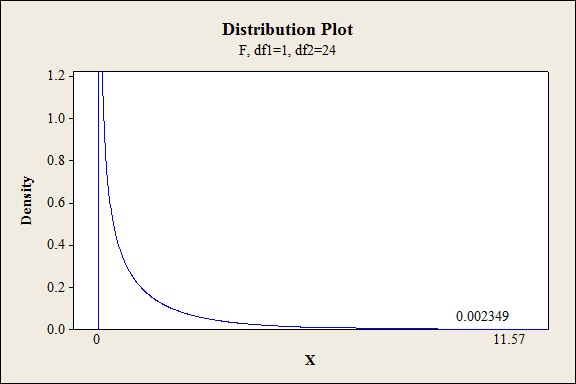
P-value for the main effect of B:
Software procedure:
Step-by-step procedure to find the P-value is given below:
- Click on Graph, select View Probability and click OK.
- Select F, enter 3 in numerator df and 24 in denominator df.
- Under Shaded Area Tab select X value under Define Shaded Area By and select right tail.
- Choose X value as 3.12.
- Click OK.
Output obtained from MINITAB is given below:
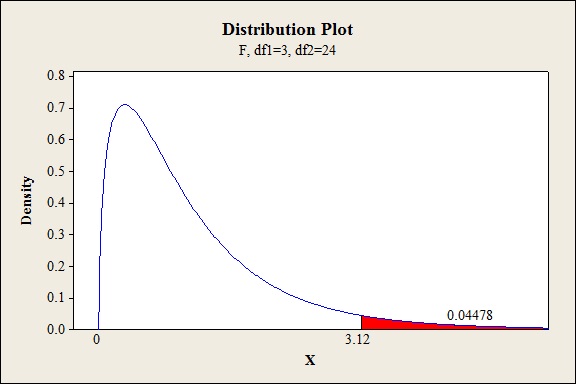
P-value for the main effect of C:
Software procedure:
Step-by-step procedure to find the P-value is given below:
- Click on Graph, select View Probability and click OK.
- Select F, enter 2 in numerator df and 24 in denominator df.
- Under Shaded Area Tab select X value under Define Shaded Area By and select right tail.
- Choose X value as 10.28.
- Click OK.
Output obtained from MINITAB is given below:
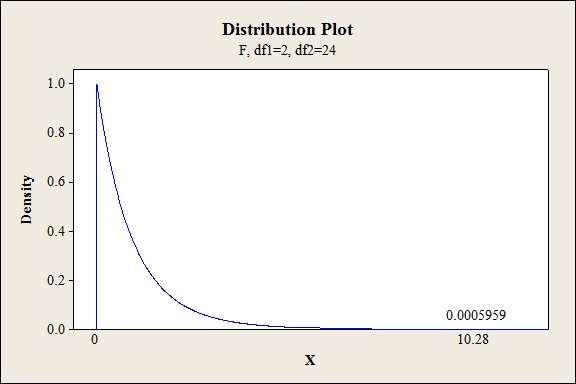
P-value for the interaction effect of AB:
Software procedure:
Step-by-step procedure to find the P-value is given below:
- Click on Graph, select View Probability and click OK.
- Select F, enter 3 in numerator df and 24 in denominator df.
- Under Shaded Area Tab select X value under Define Shaded Area By and select right tail.
- Choose X value as 2.25.
- Click OK.
Output obtained from MINITAB is given below:
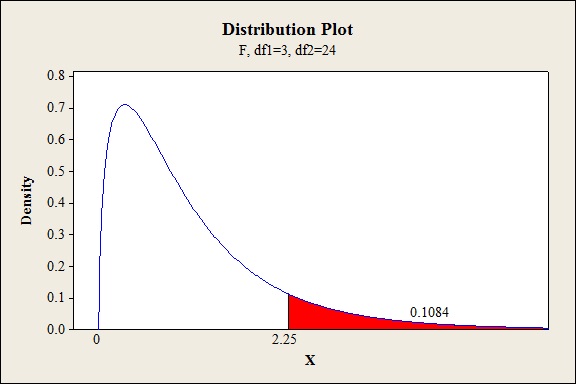
P-value for the interaction effect of BC:
Software procedure:
Step-by-step procedure to find the P-value is given below:
- Click on Graph, select View Probability and click OK.
- Select F, enter 6 in numerator df and 24 in denominator df.
- Under Shaded Area Tab select X value under Define Shaded Area By and select right tail.
- Choose X value as 4.39.
- Click OK.
Output obtained from MINITAB is given below:
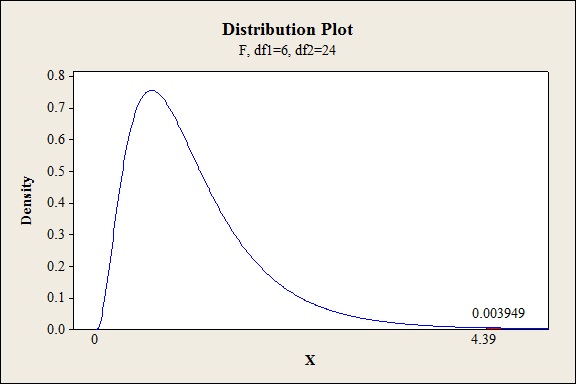
P-value for the interaction effect of AC:
Software procedure:
Step-by-step procedure to find the P-value is given below:
- Click on Graph, select View Probability and click OK.
- Select F, enter 2 in numerator df and 24 in denominator df.
- Under Shaded Area Tab select X value under Define Shaded Area By and select right tail.
- Choose X value as 6.10.
- Click OK.
Output obtained from MINITAB is given below:
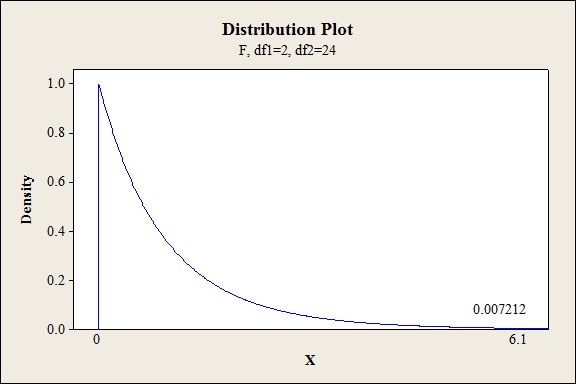
P-value for the interaction effect of ABC:
Software procedure:
Step-by-step procedure to find the P-value is given below:
- Click on Graph, select View Probability and click OK.
- Select F, enter 6 in numerator df and 24 in denominator df.
- Under Shaded Area Tab select X value under Define Shaded Area By and select right tail.
- Choose X value as 1.21.
- Click OK.
Output obtained from MINITAB is given below:
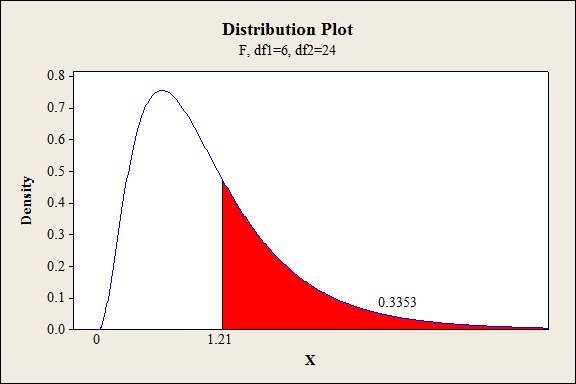
Conclusion:
For the main effect of A:
The P- value for the factor A (vat pressure) is 0.002 and the level of significance is 0.05.
Here, the P- value is lesser than the level of significance.
That is,
Thus, the null hypothesis is rejected,
Hence, there is sufficient of evidence to conclude that there is an effect of vat pressure on the strength of the paper at 5% level of significance.
For main effect of B:
The P- value for the factor B (cooking times) is 0.044 and the level of significance is 0.05.
Here, the P- value is lesser than the level of significance.
That is,
Thus, the null hypothesis is rejected.
Hence, there is sufficient of evidence to conclude that there is an effect of cooking times on the strength of the paper at 5% level of significance.
For main effect of C:
The P- value for the factor C (concentrations) is 0.000 and the level of significance is 0.05.
Here, the P- value is lesser than the level of significance.
That is,
Thus, the null hypothesis is rejected.
Hence, there is sufficient of evidence to conclude that there is an effect of concentrations on the strength of the paper at 5% level of significance.
For the interaction effect of AB:
The P- value for the interaction effect AB (vat pressure and cooking times) is 0.1084 and the level of significance is 0.05.
Here, the P- value is greater than the level of significance.
That is,
Thus, the null hypothesis is not rejected,
Hence, there is no sufficient of evidence to conclude that there is an interaction effect of vat pressure and cooking times on the strength of the paper at 5% level of significance.
For the interaction effect of BC
The P- value for the interaction effect BC (cooking times and concentrations) is 0.004 and the level of significance is 0.05.
Here, the P- value is lesser than the level of significance.
That is,
Thus, the null hypothesis is rejected,
Hence, there is sufficient of evidence to conclude that there is an interaction effect of cooking times and concentrations on the strength of the paper at 5% level of significance.
For the interaction effect of AC:
The P- value for the interaction effect AC (vat pressure and concentrations) is 0.0072 and the level of significance is 0.05.
Here, the P- value is lesser than the level of significance.
That is,
Thus, the null hypothesis is rejected,
Hence, there is sufficient of evidence to conclude that there is an interaction effect of vat pressure and concentrations on the strength of the paper at 5% level of significance.
For the interaction effect of ABC:
The P- value for the interaction effect ABC (vat pressure, cooking times and concentrations) is 0.3353 and the level of significance is 0.05.
Here, the P- value is greater than the level of significance.
That is,
Thus, the null hypothesis is not rejected,
Hence, there is no sufficient of evidence to conclude that there is an interaction effect of vat pressure, cooking times and concentrations on the strength of the paper at 5% level of significance.
The main effect A, B and C appears to be significant at 5% level. The interactions BC and AC are significant at 5% level of significance and the interactions AB and ABC are not significant at 5% level of significance.
Want to see more full solutions like this?
Chapter 11 Solutions
Bundle: Probability and Statistics for Engineering and the Sciences, Loose-leaf Version, 9th + WebAssign Printed Access Card, Multi-Term Courses
- High Cholesterol: A group of eight individuals with high cholesterol levels were given a new drug that was designed to lower cholesterol levels. Cholesterol levels, in milligrams per deciliter, were measured before and after treatment for each individual, with the following results: Individual Before 1 2 3 4 5 6 7 8 237 282 278 297 243 228 298 269 After 200 208 178 212 174 201 189 185 Part: 0/2 Part 1 of 2 (a) Construct a 99.9% confidence interval for the mean reduction in cholesterol level. Let a represent the cholesterol level before treatment minus the cholesterol level after. Use tables to find the critical value and round the answers to at least one decimal place.arrow_forwardI worked out the answers for most of this, and provided the answers in the tables that follow. But for the total cost table, I need help working out the values for 10%, 11%, and 12%. A pharmaceutical company produces the drug NasaMist from four chemicals. Today, the company must produce 1000 pounds of the drug. The three active ingredients in NasaMist are A, B, and C. By weight, at least 8% of NasaMist must consist of A, at least 4% of B, and at least 2% of C. The cost per pound of each chemical and the amount of each active ingredient in one pound of each chemical are given in the data at the bottom. It is necessary that at least 100 pounds of chemical 2 and at least 450 pounds of chemical 3 be used. a. Determine the cheapest way of producing today’s batch of NasaMist. If needed, round your answers to one decimal digit. Production plan Weight (lbs) Chemical 1 257.1 Chemical 2 100 Chemical 3 450 Chemical 4 192.9 b. Use SolverTable to see how much the percentage of…arrow_forwardAt the beginning of year 1, you have $10,000. Investments A and B are available; their cash flows per dollars invested are shown in the table below. Assume that any money not invested in A or B earns interest at an annual rate of 2%. a. What is the maximized amount of cash on hand at the beginning of year 4.$ ___________ A B Time 0 -$1.00 $0.00 Time 1 $0.20 -$1.00 Time 2 $1.50 $0.00 Time 3 $0.00 $1.90arrow_forward
- For each of the time series, construct a line chart of the data and identify the characteristics of the time series (that is, random, stationary, trend, seasonal, or cyclical). Year Month Rate (%)2009 Mar 8.72009 Apr 9.02009 May 9.42009 Jun 9.52009 Jul 9.52009 Aug 9.62009 Sep 9.82009 Oct 10.02009 Nov 9.92009 Dec 9.92010 Jan 9.82010 Feb 9.82010 Mar 9.92010 Apr 9.92010 May 9.62010 Jun 9.42010 Jul 9.52010 Aug 9.52010 Sep 9.52010 Oct 9.52010 Nov 9.82010 Dec 9.32011 Jan 9.12011 Feb 9.02011 Mar 8.92011 Apr 9.02011 May 9.02011 Jun 9.12011 Jul 9.02011 Aug 9.02011 Sep 9.02011 Oct 8.92011 Nov 8.62011 Dec 8.52012 Jan 8.32012 Feb 8.32012 Mar 8.22012 Apr 8.12012 May 8.22012 Jun 8.22012 Jul 8.22012 Aug 8.12012 Sep 7.82012 Oct…arrow_forwardFor each of the time series, construct a line chart of the data and identify the characteristics of the time series (that is, random, stationary, trend, seasonal, or cyclical). Date IBM9/7/2010 $125.959/8/2010 $126.089/9/2010 $126.369/10/2010 $127.999/13/2010 $129.619/14/2010 $128.859/15/2010 $129.439/16/2010 $129.679/17/2010 $130.199/20/2010 $131.79 a. Construct a line chart of the closing stock prices data. Choose the correct chart below.arrow_forwardFor each of the time series, construct a line chart of the data and identify the characteristics of the time series (that is, random, stationary, trend, seasonal, or cyclical) Date IBM9/7/2010 $125.959/8/2010 $126.089/9/2010 $126.369/10/2010 $127.999/13/2010 $129.619/14/2010 $128.859/15/2010 $129.439/16/2010 $129.679/17/2010 $130.199/20/2010 $131.79arrow_forward
- 1. A consumer group claims that the mean annual consumption of cheddar cheese by a person in the United States is at most 10.3 pounds. A random sample of 100 people in the United States has a mean annual cheddar cheese consumption of 9.9 pounds. Assume the population standard deviation is 2.1 pounds. At a = 0.05, can you reject the claim? (Adapted from U.S. Department of Agriculture) State the hypotheses: Calculate the test statistic: Calculate the P-value: Conclusion (reject or fail to reject Ho): 2. The CEO of a manufacturing facility claims that the mean workday of the company's assembly line employees is less than 8.5 hours. A random sample of 25 of the company's assembly line employees has a mean workday of 8.2 hours. Assume the population standard deviation is 0.5 hour and the population is normally distributed. At a = 0.01, test the CEO's claim. State the hypotheses: Calculate the test statistic: Calculate the P-value: Conclusion (reject or fail to reject Ho): Statisticsarrow_forward21. find the mean. and variance of the following: Ⓒ x(t) = Ut +V, and V indepriv. s.t U.VN NL0, 63). X(t) = t² + Ut +V, U and V incepires have N (0,8) Ut ①xt = e UNN (0162) ~ X+ = UCOSTE, UNNL0, 62) SU, Oct ⑤Xt= 7 where U. Vindp.rus +> ½ have NL, 62). ⑥Xn = ΣY, 41, 42, 43, ... Yn vandom sample K=1 Text with mean zen and variance 6arrow_forwardA psychology researcher conducted a Chi-Square Test of Independence to examine whether there is a relationship between college students’ year in school (Freshman, Sophomore, Junior, Senior) and their preferred coping strategy for academic stress (Problem-Focused, Emotion-Focused, Avoidance). The test yielded the following result: image.png Interpret the results of this analysis. In your response, clearly explain: Whether the result is statistically significant and why. What this means about the relationship between year in school and coping strategy. What the researcher should conclude based on these findings.arrow_forward
- A school counselor is conducting a research study to examine whether there is a relationship between the number of times teenagers report vaping per week and their academic performance, measured by GPA. The counselor collects data from a sample of high school students. Write the null and alternative hypotheses for this study. Clearly state your hypotheses in terms of the correlation between vaping frequency and academic performance. EditViewInsertFormatToolsTable 12pt Paragrapharrow_forwardA smallish urn contains 25 small plastic bunnies – 7 of which are pink and 18 of which are white. 10 bunnies are drawn from the urn at random with replacement, and X is the number of pink bunnies that are drawn. (a) P(X = 5) ≈ (b) P(X<6) ≈ The Whoville small urn contains 100 marbles – 60 blue and 40 orange. The Grinch sneaks in one night and grabs a simple random sample (without replacement) of 15 marbles. (a) The probability that the Grinch gets exactly 6 blue marbles is [ Select ] ["≈ 0.054", "≈ 0.043", "≈ 0.061"] . (b) The probability that the Grinch gets at least 7 blue marbles is [ Select ] ["≈ 0.922", "≈ 0.905", "≈ 0.893"] . (c) The probability that the Grinch gets between 8 and 12 blue marbles (inclusive) is [ Select ] ["≈ 0.801", "≈ 0.760", "≈ 0.786"] . The Whoville small urn contains 100 marbles – 60 blue and 40 orange. The Grinch sneaks in one night and grabs a simple random sample (without replacement) of 15 marbles. (a)…arrow_forwardSuppose an experiment was conducted to compare the mileage(km) per litre obtained by competing brands of petrol I,II,III. Three new Mazda, three new Toyota and three new Nissan cars were available for experimentation. During the experiment the cars would operate under same conditions in order to eliminate the effect of external variables on the distance travelled per litre on the assigned brand of petrol. The data is given as below: Brands of Petrol Mazda Toyota Nissan I 10.6 12.0 11.0 II 9.0 15.0 12.0 III 12.0 17.4 13.0 (a) Test at the 5% level of significance whether there are signi cant differences among the brands of fuels and also among the cars. [10] (b) Compute the standard error for comparing any two fuel brands means. Hence compare, at the 5% level of significance, each of fuel brands II, and III with the standard fuel brand I. [10] �arrow_forward
 College Algebra (MindTap Course List)AlgebraISBN:9781305652231Author:R. David Gustafson, Jeff HughesPublisher:Cengage Learning
College Algebra (MindTap Course List)AlgebraISBN:9781305652231Author:R. David Gustafson, Jeff HughesPublisher:Cengage Learning Algebra: Structure And Method, Book 1AlgebraISBN:9780395977224Author:Richard G. Brown, Mary P. Dolciani, Robert H. Sorgenfrey, William L. ColePublisher:McDougal Littell
Algebra: Structure And Method, Book 1AlgebraISBN:9780395977224Author:Richard G. Brown, Mary P. Dolciani, Robert H. Sorgenfrey, William L. ColePublisher:McDougal Littell Glencoe Algebra 1, Student Edition, 9780079039897...AlgebraISBN:9780079039897Author:CarterPublisher:McGraw Hill
Glencoe Algebra 1, Student Edition, 9780079039897...AlgebraISBN:9780079039897Author:CarterPublisher:McGraw Hill Holt Mcdougal Larson Pre-algebra: Student Edition...AlgebraISBN:9780547587776Author:HOLT MCDOUGALPublisher:HOLT MCDOUGAL
Holt Mcdougal Larson Pre-algebra: Student Edition...AlgebraISBN:9780547587776Author:HOLT MCDOUGALPublisher:HOLT MCDOUGAL Linear Algebra: A Modern IntroductionAlgebraISBN:9781285463247Author:David PoolePublisher:Cengage Learning
Linear Algebra: A Modern IntroductionAlgebraISBN:9781285463247Author:David PoolePublisher:Cengage Learning College AlgebraAlgebraISBN:9781305115545Author:James Stewart, Lothar Redlin, Saleem WatsonPublisher:Cengage Learning
College AlgebraAlgebraISBN:9781305115545Author:James Stewart, Lothar Redlin, Saleem WatsonPublisher:Cengage Learning





